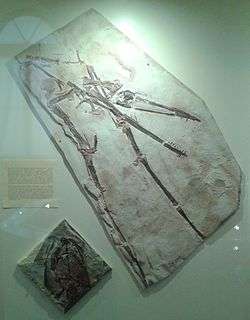Nurhachius
| Nurhachius Temporal range: Early Cretaceous, 120 Ma | |
|---|---|
 | |
| Holotype specimen cast | |
| Scientific classification | |
| Kingdom: | Animalia |
| Phylum: | Chordata |
| Class: | Reptilia |
| Order: | †Pterosauria |
| Suborder: | †Pterodactyloidea |
| Family: | †Istiodactylidae |
| Genus: | †Nurhachius Wang et al., 2005 |
| Species: | †N. ignaciobritoi |
| Binomial name | |
| Nurhachius ignaciobritoi Wang et al., 2005 | |
Nurhachius is a genus of istiodactylid pterodactyloid pterosaur from the Barremian-Aptian-age Lower Cretaceous Jiufotang Formation of Chaoyang, Liaoning, China.
The genus was named in 2005 by Wang Xiaolin, Alexander Kellner, Zhou Zhonge and Diogenes de Almeida Campos. The type species is Nurhachius ignaciobritoi. The genus name refers to Nurhaci, the first khan of the Qing Dynasty, whose original power base encompassed the region where the fossil was found. The specific name honours the late Brazilian paleontologist Ignácio Aureliano Machado Brito, who pioneered the study of pterosaurs in his country.
Description

Nurhachius was first described based on its holotype fossil, IVPP V-13288, a partial skull and skeleton. The skull is elongated with a preserved length of 315 millimetres and an estimated total length of about 330 millimetres. The nasoantorbital fenestra, the large skull opening, is relatively long at 58% of the skull length. The lower jaws have a length of 291 millimetres. The skull is similar to that of Istiodactylus, which lived at about the same time in what is now England, especially in the teeth that are compressed side to side and the long fenestra. However, it differs from Istiodactylus in several details, including a significantly lower skull, different jugal and a slight curve to the upper margin of the lower jaw. The teeth are curved to the back, have three roots and are robust. They are limited to the anterior ends of the jaws; there are 28 teeth in the upper jaws and 26 in the lower jaws for a total of 54. Most elements of the postcranial skeleton are known, with the exception of some cervical vertebrae, the ribs, the tail and the two most extreme phalanges of the wing finger. Its wingspan was estimated at 2.4-2.5 m (7.87-8.20 ft).[1]
Classification
The describers pointed out several similarities with the Pteranodontoidea and one, the warped deltopectoral crest of the humerus, unique to just the clade Istiodactylus + Anhangueridae. A cladistic analysis performed by Wang and colleagues showed that Nurhachius was a member of the Istiodactylidae. Its position as being closely related to Istiodactylus was supported by a 2008 analysis by Lü Jun-chang.[2]
In 2008 Lü also suggested that Nurhachius was a junior synonym of another istiodactlid from the same ecosystem, Liaoxipterus.[3] However, a 2012 analysis by Mark Witton found that these two istiodactylids were not identical and, more importantly, did not group together in a phylogenetic tree. Witton also noted that they did not actually group together in Lü's study either.[4]
See also
References
- ↑ Xiaolin Wang, Kellner, A.W.A., Zhou Zhonghe, and de Almeida Campos, D. (2005). Pterosaur diversity and faunal turnover in Cretaceous terrestrial ecosystems in China. Nature 437:875-879.
- ↑ J. Lü, and Q. Ji. (2006). Preliminary results of a phylogenetic analysis of the pterosaurs from western Liaoning and surrounding area. Journal of the Paleontological Society of Korea 22(1):239-261.
- ↑ Lü, J., Xu, L. and Ji, Q. (2008), "Restudy of Liaoxipterus (Istiodactylidae: Pterosauria), with comments on the Chinese istiodactylid pterosaurs", In: Hone, D. W. E. and Buffetaut, E. (eds), Flugsaurier: pterosaur papers in honour of Peter Wellnhofer, Zitteliana B28: 229–241
- ↑ Witton, Mark P. (2012). "New Insights into the Skull of Istiodactylus latidens (Ornithocheiroidea, Pterodactyloidea)". PLoS ONE. 7 (3): e33170. doi:10.1371/journal.pone.0033170. PMC 3310040
 . PMID 22470442.
. PMID 22470442.